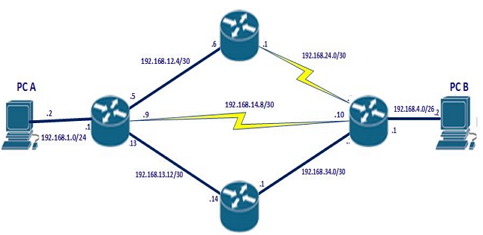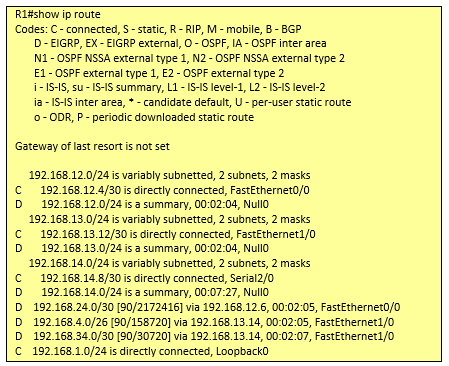As we have covered in our previous CCNA blog posts, Cisco has made both the Cisco CCENT 100-101 exam, the ICND2 200-101 exam and the CCNA 200-120 exam quite a bit more difficult than the predecessor versions of each exam. What has happened is Cisco has gone into much more detail on the various CCNA exam topics and really make it a perquisite that you have some hands on experience with Cisco routers and Cisco switches to pass your Cisco certification exams. So let’s look at today’s practice CCNA question and then we will talk about the theory of how to approach the question when you take the exam. Note that these are not actual exam questions but similar to the complex type of questions you might see on a Cisco exam which requires you to understand a topology diagram and be able to read the associated output from it. Then put it all together to understand exam concept.
Please refer to the network topology and the show ip route information below.


How will packets from PC A within the 192.168.1.0/24 LAN be forwarded to PC B on 192.168.4.0/26 LAN?
A. The router will forward packets from R1 to R2 to R4
B. The router will forward packets from R1 to R4
C. The router will forward packets from R1 to R3 to R4
D. The router will forward packets from R1 to R2 to R4 AND from R1 to R3 to R4
Before we provide you the correct answer, let’s review some of the CCNA theory behind the question.
EIGRP uses a composite metric made up of several K values. One of the K values used in determining the metric is the link cost. In this scenario, the routing table shows the route to reach the network 192.168.4.0/26 as:
D 192.168.4.0/26
The D denotes the routing protocol as EIGRP, 90 is the administrative distance and 158720, the feasible distance with 192.168.13.14 being the successor.
Feasible distance (FD) is the lowest calculated metric to reach the destination network. While the successor is the neighboring router to where the packets are sent.
This route was chosen since the Feasible Distance (FD) is lower than the reported distance of the other links to that network. Even though there are less hops through router R1 to router R4, the cost of that link is way higher therefore affecting the metric.
For more detailed explanation please refer to the topic on EIGRP and DUAL (Diffusion Update Algorithm)
CCNA & CCNP Topic Overview of EIGRP and DUAL
Correct Answer:
Now hopefully it is clear to you that the correct answer is C. The router will forward packets from R1 to
So to help you prepare for your CCNA exam, we are providing you with a sample questions from our CCNA practice exam program (these are not actual Cisco exam questions). These are the kind of questions you need to be able to think through to pass the exam and apply what you have learned to pass and get a job in the real world. You will notice that these are not easy multiple choice questions in which you can memorize the question and answer and get it right.
As Cisco is now using scenarios like the one above and what they are doing is changing the IP schema or a word or two in the question to make it more difficult to cheat by doing brain dumps. We are glad Cisco is doing this to weed out the paper CCNAs and you should be too. So if you want a quality CCNA practice exam engine, checkout our newly released Cisco CCNA 200-120 practice exam simulator. Get it at our special introductory price as we intend to raise the price in 60 days.
Additionally, it has our PASS GUARANTEE with it. If you purchase our CCNA practice exam simulator as a solo product and within 180 days after the purchase of it you fail the exam, we will refund your payment 100%. You will simply need to fax us in a copy of your failed score report. This is only available to the original purchaser of the practice exam simulator.
So don’t settle for inferior CCNA exam prep tools. Get the best with CertificationKits! See our new CertificationKits CCNA Practice Exam Simulator here.
